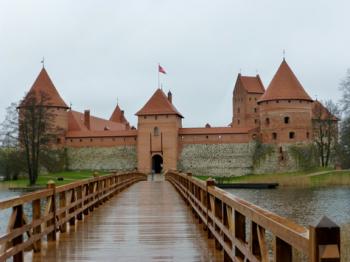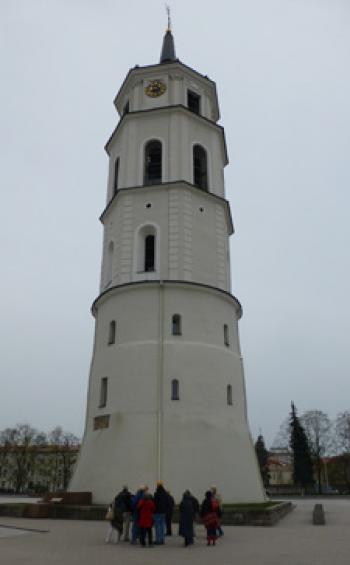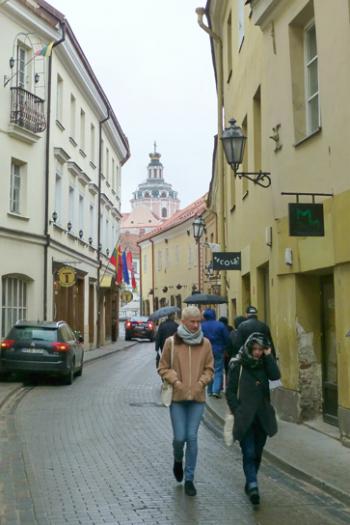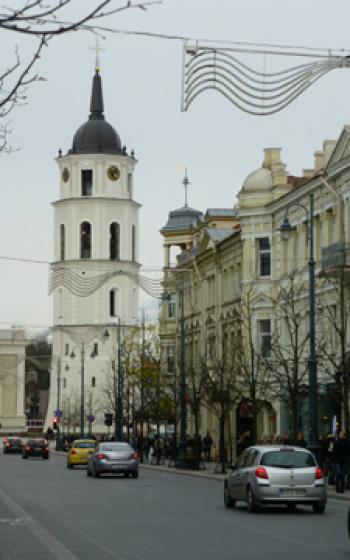The Baltics (Part 1 of 3)
This item appears on page 56 of the August 2017 issue.
Vilnius, Lithuania
(First of three parts)
In late April, I had an opportunity to travel to the Baltic States — Lithuania, Latvia and Estonia — as well as to Berlin and Helsinki with smarTours (New York, NY; 800/337-7773, www.smartours.com) on a partially hosted basis.
I was part of a group of 15 on the 14-day tour “Baltic States & Berlin,” featuring the cities of Vilnius, Riga, Tallinn, Berlin and Helsinki. It is priced from $2,899 per person, double occupancy, including air from New York’s JFK, all internal flights, 12 buffet breakfasts and four dinners. The single supplement is $479.
The Finnair experience
The tour uses Finnair (877/757-7143, www.finnair.com) both to Europe and on four intra-Europe flights. I had flown Finnair to Scandinavia in 2015 so was already something of a fan of the carrier. Today they fly to 70 destinations in Europe and 17 cities in Asia. Finnair’s US gateways are New York, Chicago and San Francisco, with Miami a seasonal option.
Our flight to Helsinki from New York was on an impressive A-350 Airbus. I had the opportunity to fly in Business Class outbound — a pure joy of space and comfort — and in Economy Comfort class on the return.
I was particularly impressed with the reasonable costs of the upgrade options: $500-$600 for Business Class and $80-$90 for Economy Comfort in each direction. On the return flight from Helsinki, most of our group did upgrade to Economy Comfort, each enjoying the extra legroom, meals, an amenity kit and noise-canceling headphones.
Part of the oneworld alliance, in which American Airlines and British Airways are also members, Finnair is a good option when planning European travel. For those on the east coast of the US, Finnair also can be an option for many Asian destinations, traveling over the top of the globe via Helsinki.
Lithuania beckons
Up front, I will acknowledge being quite moved by this visit to the Baltics. We visited Lithuania, Latvia and then Estonia, traveling from south to north.
While all three countries have had and continue to face economic and political challenges, the people there are pure survivors. They endured long periods of harsh Soviet domination both before and after WWII and some three years of murderous Nazi occupation during the war.
Lithuania finally gained its freedom from the Soviets in August 1991. While the long-awaited taste of freedom was sweet, several years of economic hardship followed.
In 2004, Lithuania became a member of NATO and then the European Union, and in 2007 Lithuania joined the Schengen Agreement, all of which has delivered greater prosperity and a level of national security never before known and has helped to allay fears about any possible Russian incursions into the region.
Lithuania’s population is only about 2.9 million, with just over 800,000 in the capital city of Vilnius and surrounds. It remains the most economically challenged of the three Baltic nations and, as a result, experiences a most unfortunate brain drain of many of its most educated youth.
Ethnic Lithuanians today represent some 87% of the the nation’s population. Physically, they are quite tall and lean. In this regard, it makes sense that the national sport is basketball, and the country usually fares well in the European championships despite its relatively tiny population. Currently, no fewer than five Lithuanians are participating at the sport’s highest echelon, in the NBA.
Vilnius enchants
For three nights, our group was accommodated in central Vilnius a short walk from the entrance to the medieval Old Town, the primary visitor attraction in the city.
One of the largest Old Towns in Europe, it features a plethora of well-preserved Renaissance, Baroque and Gothic structures. Impressively, the majority of those buildings are in regular use today, with the expansive campus of Vilnius University perhaps the most prominent and long-standing tenant.
For our Baltics tour, we were fortunate to have a very experienced tour director, Stephan Luscevic, a Lithuanian, who was able to immediately share much of his personal experience regarding his home city, Vilnius.
On a guided walking tour of Old Town that commenced at the Vilnius Cathedral at Cathedral Square, adjacent to the Royal Palace, Stephan unveiled a maze of narrow streets and walkways lined with restored 18th-century buildings.
We explored the university campus, with its many squares and courtyards, even popping into the campus Littera bookstore, where a few of us found university-related souvenirs definitely not available elsewhere.
We were awed by the Gothic-style Church of St. Anne and wandered the lanes of the old Jewish quarter, and some shopped for the most touted local treasure, amber. By my observance, the supposedly rare stone did not seem to be in short supply.
On a hilltop overlooking all of this is Gediminas’ Tower, a symbol of both the city and the nation.
Things to see and do
After finishing our guided walking tour in the early afternoon, Stephan invited me to try a local culinary staple at one of his favorite local eateries, Forto Dvaras (Pilies g. 16, Vilnius; phone +370 656 13688) on Pilies Street, a cobbled pedestrian byway that serves as a highly popular restaurant-and-shopping row in Old Town.
He ate and I sampled “Zeppelins,” essentially dumplings with either a meat or cottage cheese filling. (The term “acquired taste” comes to mind. Next time, I’ll opt for the potato pancakes.) The local dark beer was fantastic, with a huge serving bargain-priced at under €3 (near $3.40). This is a recommended place to try typical Lithuanian food in a traditional setting at very reasonable prices.
On this particular itinerary, we had two free afternoons for exploring on our own. Group members headed in different directions, and many shared their findings the following day.
I received positive reports on the National Museum of Lithuania and the nearby Museum of Applied Arts & Design. Another tour member advised having a very stiff drink before going to the sobering Museum of Genocide Victims, commonly referred to as the KGB Museum. Visitor options seemed endless.
This city of churches and many fine museums is also an entertainment treasure trove on weekends. On both Friday and Saturday nights, we had our choices of ballet, symphony, chamber music, choir and organ performances in Old Town.
Side trip to Trakai
On one day, we undertook an excursion to Trakai Island Castle, an alluring lakefront medieval castle that is now a museum. En route, we stopped to view the TV tower that was the site of a bloody confrontation between heavily armed Soviet troops and unarmed Lithuanian independence activists in 1991. The tower remains an important symbol of Lithuania’s struggle for freedom.
On arrival at Trakai and seeing the many visitors, we realized we were fortunate to be touring the popular destination ahead of the summer tourist season, when even larger crowds visit the rather idyllic, land-of-lakes setting. We traversed the three levels of the castle viewing exhibits from an era when Lithuania ruled a vast empire, from the Baltic Sea to the Black Sea.
The lake was crystal clear and left me lusting for a fishing rod and my favorite trout lure. Locals advised me that the lakes are popular ice-fishing venues in winter.
Good impressions
Throughout Lithuania, I was very impressed with the high quality of the roads and other primary infrastructure, due in no small way to significant contributions from the EU.
Returning to Vilnius and having late-afternoon and evening free time, I set out on a purely cultural mission. Through a combination of gall and pure luck, I was able to score a ticket to the sold-out contemporary ballet performance “Piaf,” based on the life and times of the famed, beloved and, at times, controversial French entertainer Édith Piaf.
The performance graced the splendid Lithuanian National Opera & Ballet Theatre and was simply magnificent. My well-positioned, priced-for-the-masses ticket cost, incredibly, only €11. Humbled, indeed, was this traveler by his grand good fortune on his final evening in Lithuania.
Next month, I will report on Latvia and its beautiful, Art Nouveau-endowed capital of Riga. F
You may reach Randy at 80 America Way, Jamestown, RI 02835; 401/560-0350, randykeck@yahoo.com.




